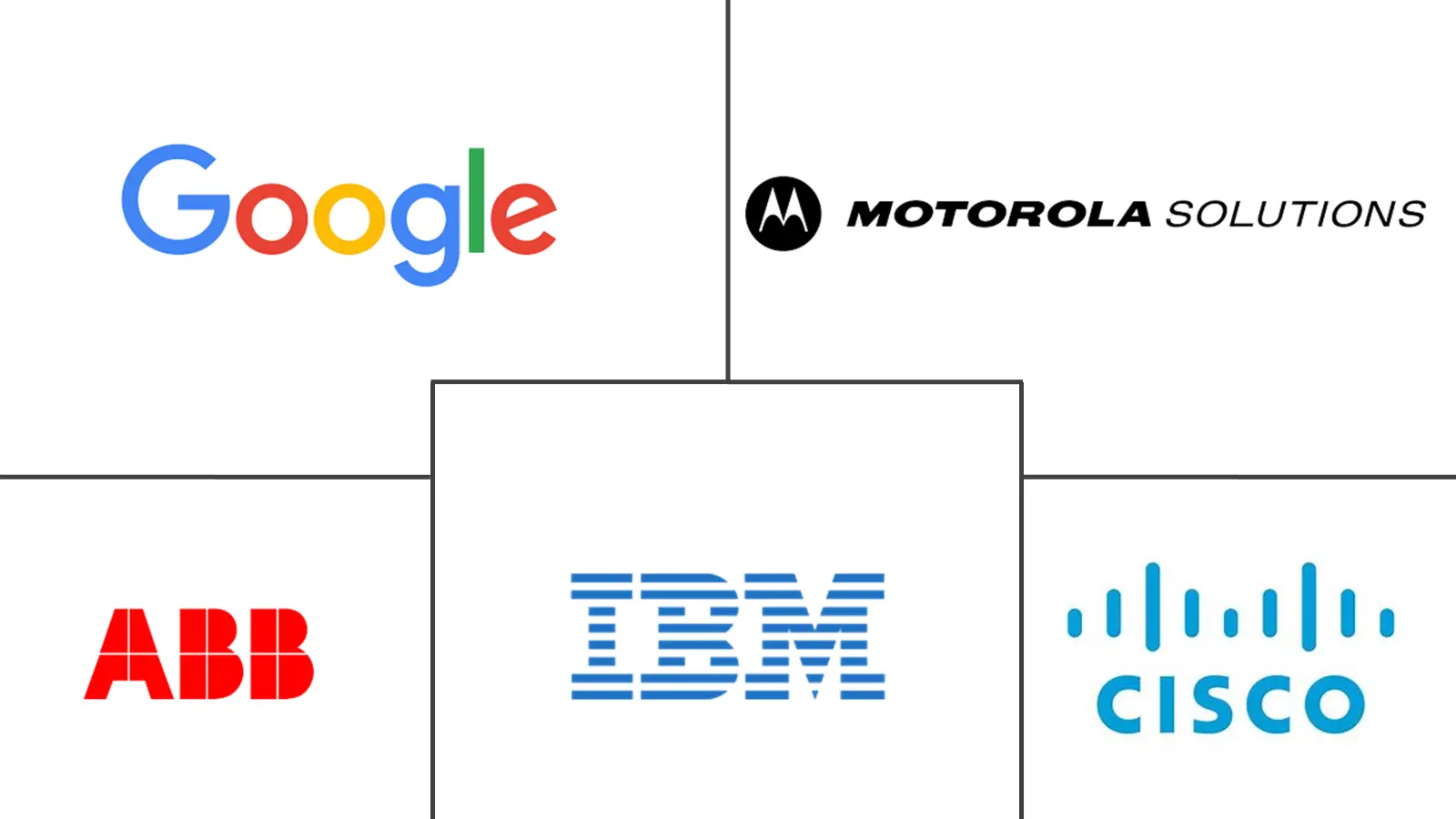Latin America Wireless Mesh Networking Market Size and Share
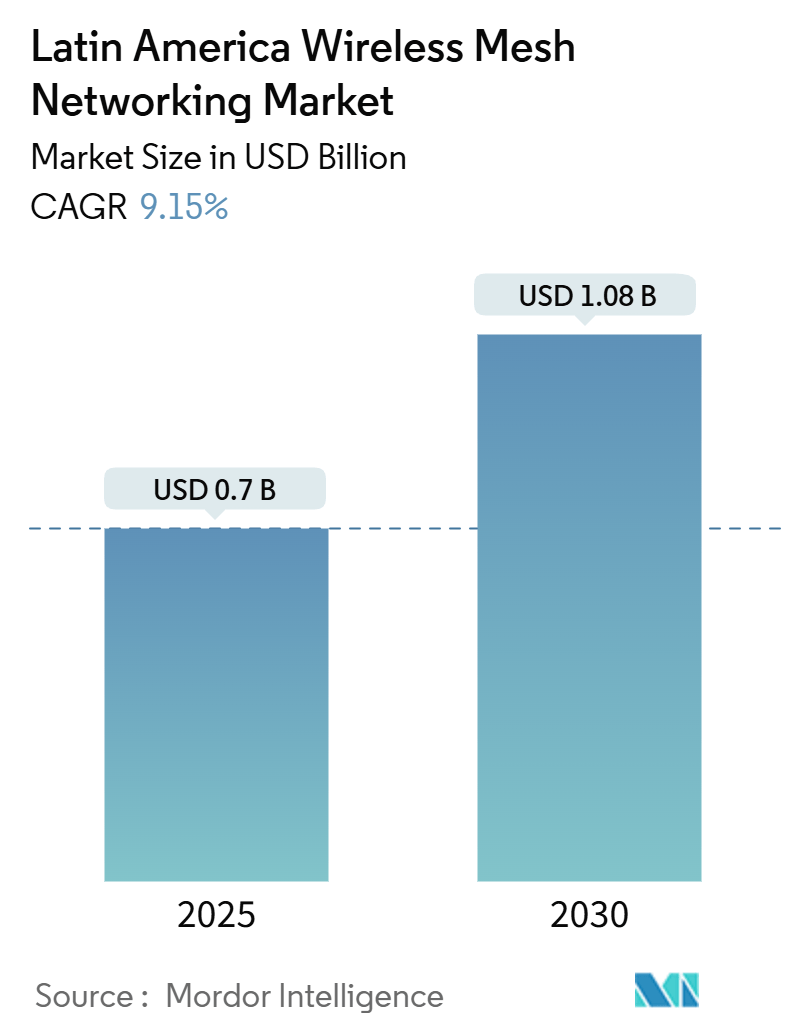
Latin America Wireless Mesh Networking Market Analysis by Mordor Intelligence
The Latin America Wireless Mesh Networking Market size is estimated at USD 0.7 billion in 2025, and is expected to reach USD 1.08 billion by 2030, at a CAGR of 9.15% during the forecast period (2025-2030).
- The surge in the market is primarily driven by the rising adoption of wireless mesh networks, which are favored for their reliable capabilities, offering faster data transmission and simplified deployment.
- The market is propelled by the increasing integration of advanced technologies like the Internet of Things (IoT) and the advent of 5G networks. This confluence of advancements reshapes connectivity paradigms, marking a significant shift in how industries connect in the digital era and deploy wireless mesh networking devices to meet the needs.
- By April 2024, 29 operators in Latin America, spanning 10 countries, had introduced commercial 5G services. Additionally, several operators have outlined plans to launch their own 5G services in the near future. This surge will be fueled by launching new 5G markets and expanding existing networks into previously uncovered regions. According to the GSMA report, 5G is poised to dominate, constituting nearly 60% of all mobile connections in Latin America by 2030.
- Transitioning to cloud-native infrastructure is pivotal for facilitating 5G standalone (5G SA) rollouts. While Latin America, like much of the world, has predominantly adopted a non-standalone (NSA) approach for its initial 5G deployments, Brazil stands out with its emphasis on 5G SA networks. Nonetheless, the rest of the region is poised to witness a surge in 5G SA availability. According to GSMA Intelligence, 55% of Latin American operators already operating 5G networks have committed to transitioning to 5G SA, following the global trend.
- Wireless mesh networking is crucial in developing innovative city applications, including intelligent traffic management, environmental monitoring, and bright lighting. Fira de Barcelona awarded Brazil as the Smart City of 2023 at the World Smart City Awards gala held at the Smart City Expo World Congress (SCEWC) to appreciate innovative initiatives and projects in the urban transformation industry. Cities such as Santiago (Chile) and Sao Paulo (Brazil) are investing in technologies to enhance urban living, which is driving the growth of the market studied.
- The high initial costs and maintenance expenses restrict the integration of wireless mesh networking, especially in rural areas. It is heavily dependent on government grants, international aid, or public-private partnerships, which create challenges for the market to prosper in every area of Latin America.
Latin America Wireless Mesh Networking Market Trends and Insights
Enterprise is Expected to Record the Fastest CAGR
- In Latin America, the fastest-growing segment is driven by enterprise demand. Enterprises are increasingly opting for wireless mesh networks for secure connectivity solutions. The rise of demand for digital transformation in 5G deployment requires reliable and high-capacity networks to support technologies such as IoT, cloud computing, and big data analytics. As per the GSMA report, Brazil is expected to reach 77%, followed by Chile, with a 68% penetration rate of 5G total connections by 2030.
- Capitalizing on this trend, the market can introduce innovative solutions like intelligent traffic management, electric and connected vehicles, and upgraded public transportation systems. Strategic collaborations between technology providers and city authorities offer a unique chance to develop cohesive, eco-friendly mobility solutions.
- Governments and enterprises are collaborating on smart city projects, which invest in projects that heavily rely on wireless mesh networks to connect various IoT devices and sensors. The Mexican government's dedication to urban development, underscored by its focus on integrating smart technologies, stands out as a key market driver.
- As evidenced by initiatives like the National Digital Strategy and the Smart Cities Challenge, Mexico is proactively tackling urban issues. This emphasis on digital infrastructure, connectivity, and data-driven decision-making drives the widespread adoption of smart solutions, spanning industries from transportation and energy to healthcare and public safety.
- Several Latin American nations are adopting technology to meet their sustainability targets. They are increasingly turning to IoT devices to bolster their green initiatives, fueling a rising need for wireless mesh networks. Curitiba, known as the "green capital of Brazil," is an example. The city has made significant strides with its low-carbon endeavors, such as implementing a bus rapid transit system, establishing an extensive network of bike paths and green spaces, and promoting recycling and composting through its waste management system. Notably, Curitiba has set its targets on achieving carbon neutrality by 2050.
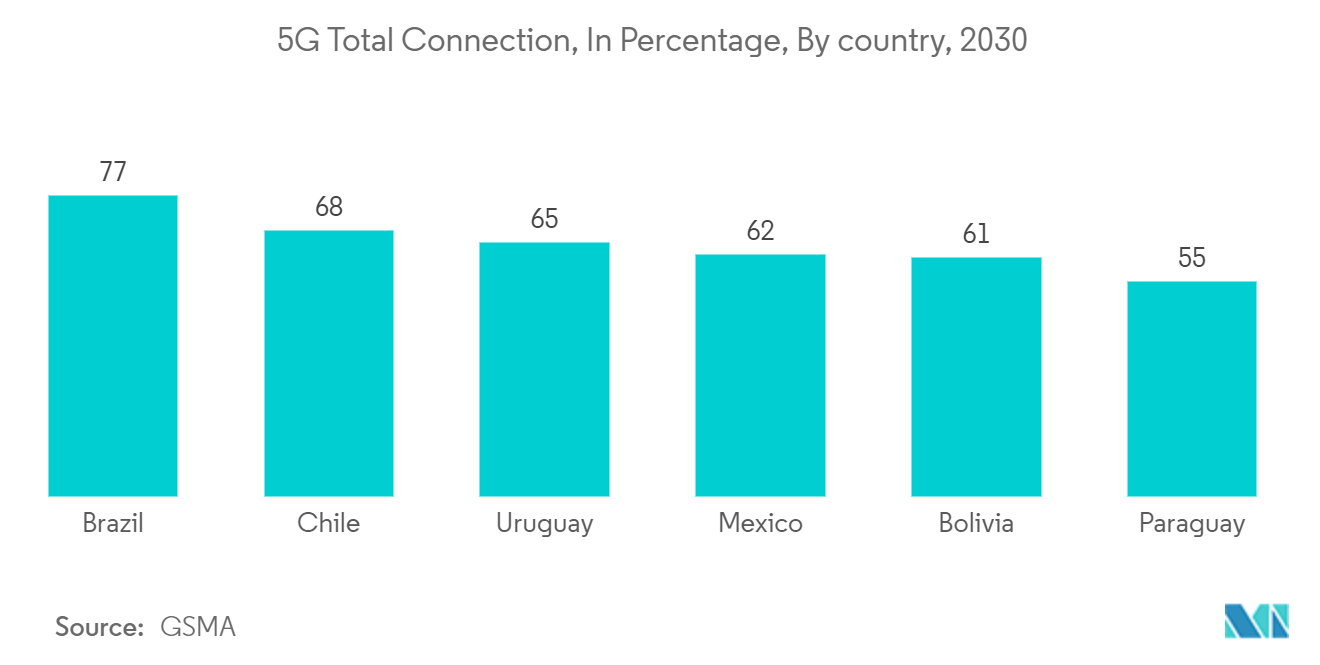
Brazil Holds the Largest Market Share
- The Brazilian wireless mesh networking market is expanding significantly. This expansion is due to the need for dependable and effective communication infrastructures, which are crucial to sustaining the growing network of interconnected devices in smart homes, industries, and other sectors.
- Brazilian cities are investing in initiatives gaining international recognition to facilitate a globally interconnected landscape. These efforts, often resulting from collaborative endeavors, harness digital tools and emphasize citizen involvement. Innovations like the Internet of Things (IoT) and the advent of 5G technology have revolutionized the interaction between citizens and public domains, reshaping the very essence of civic engagement. Consequently, prioritizing investments in connectivity becomes paramount, establishing the foundation for inclusive, digitally-driven governance structures. According to the data from GSMA Intelligence, 5G contribution is expected to reach USD 26 billion by 2030.
- Brazil's increasing demand for tailored private 5G networks underscores the new opportunities for the potential of 5G. Cloud-based services in Brazil are leveraging 5G for its imperative high-speed and low-latency requirements. TIM Brasil has seized on this by rolling out its cloud gaming services. Additionally, Claro Brasil, in collaboration with Ericsson and Niantic, trialed AR gaming specifically on 5G SA networks. The advent of 5G enhances the performance of wireless mesh networks and paves the way for seamless real-time applications in various sectors, from video conferencing and telemedicine to corporate and educational platforms.
- Curitiba, Brazil, received the prestigious Smart City award at the recent Smart City Expo World Congress in Barcelona. These awards spotlight advanced urban innovation projects globally. The jury lauded Curitiba's urban planning strategies, socioeconomic development strides, and commitment to environmental sustainability. As Curitiba embraces smart city initiatives, there is a growing role for wireless networking mesh, which facilitates internet connectivity and is pivotal in enhancing real-time tracking and communication within its public transportation network. Moreover, the city's streetlights, linked through WMNs, allow real-time updates on pedestrian and vehicular traffic and automatically report outages, bolstering energy efficiency and public safety.
- Many market players in Brazil are investing in advanced technologies to upgrade wireless networking mesh devices. For instance, in October 2023, at Futurecom Brazil, Latin America's premier communications exhibition, FiberHome unveiled its advanced Wi-Fi7 Home Gateway. This next-gen gateway announced remarkable enhancements in network latency, throughput, and connectivity. These improvements are poised to elevate home network experiences, aligning perfectly with the growing demands of digitalized homes.
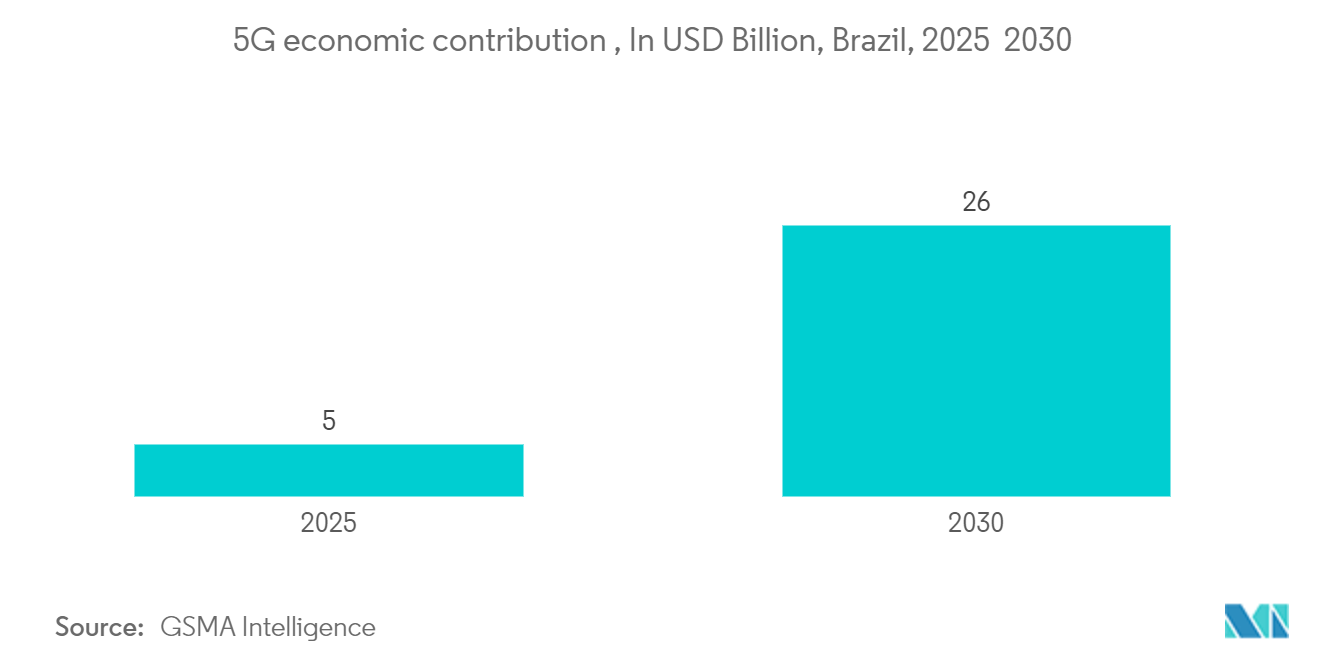
Competitive Landscape
The Latin American wireless mesh networking market is highly competitive. Key players in the market, such as Motorola Solutions Inc., ABB (Tropos Networks Inc.), Cisco Systems, Google, and Qualcomm Inc., dominate the market in terms of their share. Moreover, the variables are involved in various mergers and acquisitions and product innovation, among others, to gain a competitive edge over other companies.
In April 2024, Qualcomm Technologies, an American semiconductor company, unveiled advanced industrial and embedded AI platforms alongside a micro-power WiFi SoC (system on a chip). Qualcomm's latest offering, the QCC730, latest launch claimed to reduce power consumption by up to 88% compared to previous generations. This advancement is poised to significantly benefit battery-powered devices in both industrial and consumer applications.
At CES 2024, ASUS unveiled its latest offerings, the ZenWiFi BQ16 and ZenWiFi BQ16 Pro mesh routers. These routers boast next-gen quad-band WiFi 7, delivering speeds of up to 30 Gbps and an impressive coverage area of up to 8000 sq. ft (2pk), ideal for modern smart homes. Additionally, with dual 10 Gbps ports, users can enjoy enhanced wired gaming experiences, bolstering work-from-home productivity and seamless 4K HDR entertainment streaming. This product is available in Brazil through ASUS's official distribution channels.
Latin America Wireless Mesh Networking Industry Leaders
-
Motorola Solutions, Inc.
-
ABB (Tropos Networks Inc.)
-
Cisco Systems
-
Google
-
Qualcomm, Inc.
- *Disclaimer: Major Players sorted in no particular order
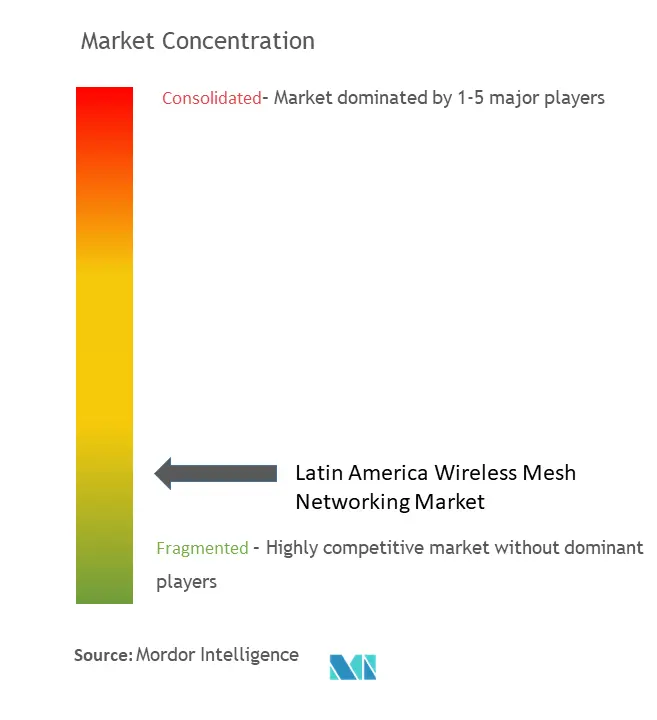
Recent Industry Developments
- April 2024: Telecom Argentina and Intraway announced a pivotal move by signing a memorandum of understanding. This agreement paves the way for a collaborative venture, a digital entity. Their primary goal is to craft a cloud-native software solution tailored for communication service providers in Latin America. This solution aims to expedite how these providers can increase profit from their networks and ensure security and scalability. This initiative aligns with the GSMA Open Gateway's vision to implement the platform already developed jointly between Telecom and Intraway. This alliance is in line with the criteria of the Open Gateway standard and its multi-platform spirit. It may enable the company to interoperate transparently with other solutions in the industry.
- November 2023: Globalsat Group, a leading global provider of satellite and wireless connectivity solutions, teamed up with Rivada Space Networks. Their collaboration aims to offer an advanced data network, with the launch of OuterNET™, to clients across Latin America and beyond, spanning industries like energy, government, agriculture, utilities, and transportation. This innovative network architecture integrates inter-satellite laser links with advanced onboard processing, enabling unparalleled routing and switching capabilities, effectively forming an optical mesh network in space.
- May 2023: Microsoft unveiled an ambitious plan to bolster its Airband partnerships, aiming to deliver high-speed internet access to approximately 40 million individuals in Latin America and Africa. These collaborations, spanning from Brazil, Chile, Colombia, and Guatemala to Cote d’Ivoire, Kenya, Nigeria, Tanzania, and Uganda, underscore the company's dedication to reaching 250 million individuals in underprivileged regions globally, with a particular focus on Africa, where 100 million lack adequate internet access.
Latin America Wireless Mesh Networking Market Report Scope
The report on the Latin American wireless mesh networking market tracks the revenue generated by the sale of mesh networking systems and devices (such as mesh routers, extenders, gateways, and clients) provided by market vendors to various end users across Latin America.
Latin America Wireless mesh networking market report is segmented by end-user type [consumers and enterprises (small and medium-sized enterprises, large enterprises)] and by country (Brazil, Mexico, Argentina, Colombia, and Rest of Latin America). The market sizes and forecasts are provided in terms of value (USD) for all the above segments.
| Consumers (Residential) | |
| Enterprises (Commercial, Industrial, Government) | Small and Medium-sized Enterprises |
| Large Enterprises |
| Brazil |
| Mexico |
| Argentina |
| Colombia |
| By End-user Type (Market Estimates, Forecast, Trends and Other Market Dynamics) | Consumers (Residential) | |
| Enterprises (Commercial, Industrial, Government) | Small and Medium-sized Enterprises | |
| Large Enterprises | ||
| By Country (Market Size Estimates & Forecast, Trends, and Other Market Dynamics) | Brazil | |
| Mexico | ||
| Argentina | ||
| Colombia | ||
Key Questions Answered in the Report
How big is the Latin America Wireless Mesh Networking Market?
The Latin America Wireless Mesh Networking Market size is expected to reach USD 0.7 billion in 2025 and grow at a CAGR of 9.15% to reach USD 1.08 billion by 2030.
What is the current Latin America Wireless Mesh Networking Market size?
In 2025, the Latin America Wireless Mesh Networking Market size is expected to reach USD 0.7 billion.
Who are the key players in Latin America Wireless Mesh Networking Market?
Motorola Solutions, Inc., ABB (Tropos Networks Inc.), Cisco Systems, Google and Qualcomm, Inc. are the major companies operating in the Latin America Wireless Mesh Networking Market.
What years does this Latin America Wireless Mesh Networking Market cover, and what was the market size in 2024?
In 2024, the Latin America Wireless Mesh Networking Market size was estimated at USD 0.64 billion. The report covers the Latin America Wireless Mesh Networking Market historical market size for years: 2020, 2021, 2022, 2023 and 2024. The report also forecasts the Latin America Wireless Mesh Networking Market size for years: 2025, 2026, 2027, 2028, 2029 and 2030.
Page last updated on:
Latin America Wireless Mesh Networking Market Report
Statistics for the 2025 Latin America Wireless Mesh Networking market share, size and revenue growth rate, created by Mordor Intelligence™ Industry Reports. Latin America Wireless Mesh Networking analysis includes a market forecast outlook for 2025 to 2030 and historical overview. Get a sample of this industry analysis as a free report PDF download.
